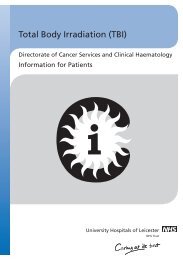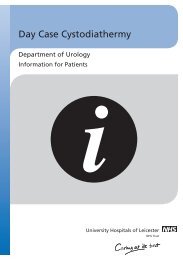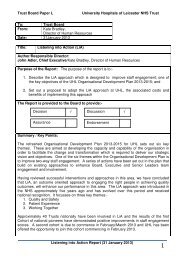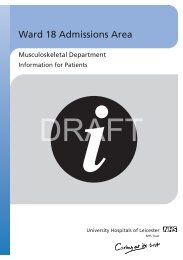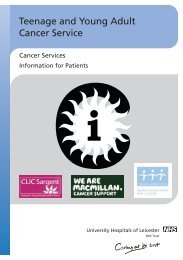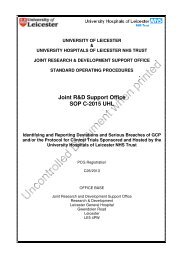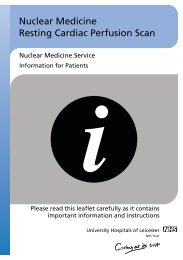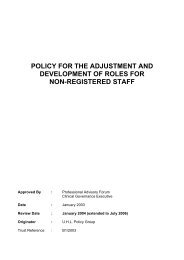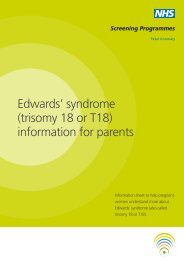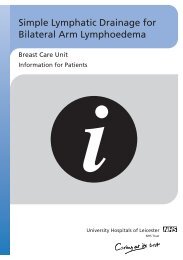Paper BB Whole - Library - University Hospitals of Leicester NHS Trust
Paper BB Whole - Library - University Hospitals of Leicester NHS Trust
Paper BB Whole - Library - University Hospitals of Leicester NHS Trust
You also want an ePaper? Increase the reach of your titles
YUMPU automatically turns print PDFs into web optimized ePapers that Google loves.
<strong>Trust</strong> Board <strong>Paper</strong> <strong>BB</strong>To: <strong>Trust</strong> BoardFrom: Chief Nurse/ Deputy ChiefExecutiveDate: 25 April 2013CQC Outcome 16 – Assessing andregulation: Monitoring the Quality <strong>of</strong> ServiceProvisionTitle: UHL BOARD ASSURANCE FRAMEWORK (BAF) 2012/13Author/Responsible Director: Chief Nurse/Deputy Chief ExecutivePurpose <strong>of</strong> the Report:To provide the Board with an updated BAF for assurance and scrutiny.The Report is provided to the Board for:Decision Discussion XAssurance X EndorsementSummary / Key Points:• 11 actions were due for completion in March 2013 and <strong>of</strong> these, 8 havebeen completed and 3 have deadlines that have been extended.• There have been no changes to BAF risk scores since the previous month,however following delivery <strong>of</strong> the £46k year end surplus (subject toaccounts sign-<strong>of</strong>f by Internal Audit) the Board is asked to advise as towhether the score assigned to risk 8 (failure to achieve financialsustainability) should be reduced from 25.• Following recommendations from RSM Tenon the Board is asked to advise<strong>of</strong> any other relevant external sources <strong>of</strong> assurance that could be includedon future iterations <strong>of</strong> the BAF.• A further recommendation asks the Board to consider and advise whetherranking the BAF risks by strategic objective would add any more valuethan retaining the current risk score ranking system.• Board members are invited to review the following risks:Risk 2: Business Continuity.Risk 4: Failure to transform the emergency care system.Risk 12: Inadequate reconfiguration <strong>of</strong> buildings and services.RecommendationsTaking into account the contents <strong>of</strong> this report and its appendices the Board isinvited to:(a) review and comment upon this iteration <strong>of</strong> the BAF, as it deems
<strong>Trust</strong> Board <strong>Paper</strong> <strong>BB</strong>appropriate:(b) note the actions identified within the framework to address any gaps ineither controls or assurances (or both);(c) identify any areas in respect <strong>of</strong> which it feels that the <strong>Trust</strong>’s controlsare inadequate and do not, therefore, effectively manage the principalrisks to the organisation meeting its objectives;(d) identify any gaps in assurances about the effectiveness <strong>of</strong> the controlsin place to manage the principal risks; and consider the nature <strong>of</strong>, andtimescale for, any further assurances to be obtained, in consequence;(e) identify any other actions which it feels need to be taken to address any‘significant control issues’ to provide assurance on the <strong>Trust</strong> meeting itsprincipal objectives;(f) With reference to section 2.4 <strong>of</strong> this report; to advise as to whether thecurrent risk score <strong>of</strong> 25 assigned to risk number 8 should be reduced.Previously considered at another corporate UHL Committee?NoStrategic Risk RegisterYesPerformance KPIs year to dateNoResource Implications (e.g. Financial, HR)N/AAssurance ImplicationsYesPatient and Public Involvement (PPI) ImplicationsYes.Equality ImpactN/AInformation exempt from DisclosureNoRequirement for further review?Yes. Monthly at Executive Team and Board meetings.
UNIVERSITY HOSPITALS OF LEICESTER <strong>NHS</strong> TRUSTREPORT TO:TRUST BOARDDATE: 25 APRIL 2013REPORT BY:CHIEF NURSE/ DEPUTY CHIEF EXECUTIVESUBJECT: UHL BOARD ASSURANCE FRAMEWORK (BAF) 2012/13-----------------------------------------------------------------------------------------------------------------1. INTRODUCTION1.1 This report provides the Board with:-a) A copy <strong>of</strong> the Board Assurance Framework (BAF) as <strong>of</strong> 31 March2013.b) A heat map <strong>of</strong> risk movements from the previous month.c) A summary <strong>of</strong> progress <strong>of</strong> actions due for completion in the reportingperiod.d) Suggested parameters for scrutiny <strong>of</strong> the BAF.2. POSITION AS OF 31 MARCH 20132.1 An updated version <strong>of</strong> the BAF is attached at appendix 1 with changes fromthe previous report highlighted in red text.2.2 A heat map to show the trend <strong>of</strong> BAF risk scores from the previous month isattached at appendix 2.2.3 There are 11 actions that were due for completion in March 2013 and <strong>of</strong>these, 8 have been completed and 3 have had deadlines extended. (Seeappendix 3 for further details).2.4 Following the delivery <strong>of</strong> the £46k year end surplus (subject to accounts sign<strong>of</strong>fby Internal Audit) the Board is asked to advise as to whether the currentrisk score assigned to risk 8 (failure to achieve financial sustainability) shouldbe reduced from its score <strong>of</strong> 25.2.5 A key element <strong>of</strong> the BAF is to assure the Board that control mechanisms areeffective and the assurances provided are designed to demonstrate this. Arecommendation from the RSM Tenon governance review is to ‘provide agreater range <strong>of</strong> assurances for inclusion in the BAF. Assurances shouldinclude wherever possible external audits, clinical audits, reports fromexternal inspectorates, etc’. The Risk and Assurance Manager has includeda number <strong>of</strong> external sources <strong>of</strong> assurance in this iteration <strong>of</strong> the BAF suchas:o PbR audit and Information Governance Toolkit audits in relation toaccuracy <strong>of</strong> clinical coding,o UHL involvement in eligible national audits and national confidentialenquiries (100% involvement during 2012/13).o Review <strong>of</strong> SHMI and other mortality data by Boston ConsultancyGroup.1
The Board are asked to advise <strong>of</strong> any other relevant external sources <strong>of</strong>assurance that could be included on future iterations <strong>of</strong> the BAF.2.6 A further recommendation from RSM Tenon asks the <strong>Trust</strong> to ‘considerrenaming the SRR/BAF the BAF and ranking risks by strategic goal orobjective rather than by risk rating’. The renaming <strong>of</strong> the BAF has beenagreed however the Board are asked to consider and advise whether rankingthe risks by strategic objective would add any more value than retaining thecurrent risk score ranking system.2.7 To provide scrutiny <strong>of</strong> BAF risks on a cyclical basis, Board members areinvited to review the following risks against the parameters listed in appendix4.Risk 2:Risk 4:Risk 12:Business Continuity.Failure to transform the emergency care system.Inadequate reconfiguration <strong>of</strong> buildings and services.NB. In light <strong>of</strong> continued pressure within the Emergency Department (ED)risk number 4 is being submitted for review outside <strong>of</strong> its normal sequencing.3. RECOMMENDATIONS3.1 Taking into account the contents <strong>of</strong> this report and its appendices the Board isinvited to:(a) review and comment upon this iteration <strong>of</strong> the BAF, as it deemsappropriate:(b) note the actions identified within the framework to address any gaps ineither controls or assurances (or both);(c) identify any areas in respect <strong>of</strong> which it feels that the <strong>Trust</strong>’s controls areinadequate and do not, therefore, effectively manage the principal risks tothe organisation meeting its objectives;(d) identify any gaps in assurances about the effectiveness <strong>of</strong> the controls inplace to manage the principal risks; and consider the nature <strong>of</strong>, andtimescale for, any further assurances to be obtained, in consequence;(e) identify any other actions which it feels need to be taken to address any‘significant control issues’ to provide assurance on the <strong>Trust</strong> meeting itsprincipal objectives;(f) With reference to section 2.4 <strong>of</strong> this report; to advise as to whether thecurrent risk score <strong>of</strong> 25 assigned to risk number 8 should be reduced.Peter Cleaver,Risk and Assurance Manager,18 April 2013.2
UNIVERSITY HOSPITALS OF LEICESTER <strong>NHS</strong> TRUST – BOARD ASSURANCE FRAMEWORKBOARD ASSURANCE FRAMEWORK - MARCH 2013Risk4Risk1Risk5Risk9Risk3Risk11Risk2Risk8Risk6Risk7Risk12N.B. Action dates are end <strong>of</strong> month unless otherwise stated Page 1
UNIVERSITY HOSPITALS OF LEICESTER <strong>NHS</strong> TRUST – BOARD ASSURANCE FRAMEWORKPERIOD: 1 MARCH – 31 MARCH 2013RISK TITLE STRATEGIC OBJECTIVE CURRENTSCORERisk 8 – failure to achieve financial sustainability g - To be a sustainable, high performing <strong>NHS</strong> Foundation <strong>Trust</strong> 25 12Risk 4 – failure to transform the emergency care system b - To enable joined up emergency care 20 12Risk 3 – inability to recruit, retain, develop and motivate staff f - To maintain a pr<strong>of</strong>essional, passionate and valued workforce 16 12e - To enjoy an enhanced reputation in research, innovation andclinical education.Risk 7 – ineffective organisational transformation a - To provide safe, high quality patient-centred health care 16 12Risk 6 – failure to achieve FT status g - To be a sustainable, high performing <strong>NHS</strong> Foundation <strong>Trust</strong> 16 12Risk 11 – failure to maintain productive relationships d - To enable integrated care closer to home 15 10Risk 9 – failure to achieve and sustain operational targets c - To be the provider <strong>of</strong> choice 12 12Risk 12 – inadequate reconfiguration <strong>of</strong> buildings and services a - To provide safe, high quality patient-centred health care 12 9Risk 1 - reducing avoidable harms a - To provide safe, high quality patient-centred health care 12 6Risk 5 – patient experience/ satisfaction c - To be the provider <strong>of</strong> choice 12 6Risk 2 – business continuity g - To be a sustainable, high performing <strong>NHS</strong> Foundation <strong>Trust</strong> 9 6TARGETSCORESTRATEGIC OBJECTIVES:-a. To provide safe, high quality patient-centred health care.b. To enable joined up emergency care.c. To be the provider <strong>of</strong> choice.d. To enable integrated care closer to home.e. To enjoy an enhanced reputation in research, innovation and clinical educationf. To maintain a pr<strong>of</strong>essional, passionate and valued workforceg. To be a sustainable, high performing <strong>NHS</strong> Foundation <strong>Trust</strong>.N.B. Action dates are end <strong>of</strong> month unless otherwise stated Page 2
(What could prevent theobjective(s) being achieved)UNIVERSITY HOSPITALS OF LEICESTER <strong>NHS</strong> TRUST – BOARD ASSURANCE FRAMEWORKRISK NUMBER/ TITLE:RISK 8 – FAILURE TO ACHIEVE FINANCIAL SUSTAINABILITYLINK TO STRATEGIC OBJECTIVE(S)To be a sustainable, high performing <strong>NHS</strong> Foundation <strong>Trust</strong>.EXECUTIVE LEAD: Director <strong>of</strong> Finance and Business ServicesPrincipal RiskWhat are we doing about it?How do we know we are What are we not doing?doing it?Failure to achieve financialsustainability including:(Key Controls)What control measures or systems wehave in place to assist secure delivery<strong>of</strong> the objective (describe processrather than management group)Overarching financial governanceprocesses including PLICS processand expenditure controlsCurrent Score I x L5X5=25(Key Assurances <strong>of</strong>controls)Provide examples <strong>of</strong> recent reportsconsidered by Board or committeewhere delivery <strong>of</strong> the objectives isdiscussed and where the boardcan gain evidence that controls areeffective.Monthly /weekly financial reportingto Exec Team, F&P Committeeand BoardCost centre reporting and monthlyPLICS reportingAnnual internal and external auditprogrammesComparison with PLICSbenchmarking against other <strong>NHS</strong>organisations(Gaps in Controls C) /Assurance (A)What gaps in systems, controlsand assurance have beenidentified?How can we fill thegaps or manage therisk better?(Actions to addressgaps)Target Score I x L4x3=12TimescaleWhen will theaction becompleted?Failure to achieve CIPStrengthened CIP governancestructurePrior to accounts sign-<strong>of</strong>f by Audit,the year end surplus <strong>of</strong> £46K hasbeen achieved.Progress in delivery <strong>of</strong> CIPs ismonitored by CIP ProgrammeBoard (meeting fortnightly) andreported to ET and Board.(c) CIP shortfall <strong>of</strong> £4.6m.Locum expenditureWorkforce plan to identify effectivemethods to recruit to ‘difficult to fill’areasReinstatement <strong>of</strong> weekly workforcepanel to approve all new posts.The use <strong>of</strong> locum staff in ‘difficultto fill’ areas is reported to theBoard on a monthly basis via theQuality and Performance report. Areduction in the use <strong>of</strong> such staffwould be an assurance <strong>of</strong> oursuccess in recruiting substantivestaff to ‘difficult to fill’ areas.Increase in substantive staff <strong>of</strong>200wte to Oct 12.(c) Failure to reduce locum spend.587 wte locum staff currently usedSTAFFflow for medical locums saving£130k <strong>of</strong> every £1m expenditureSaving in excess <strong>of</strong> £0.6m 5weeks after ‘go live’ dateN.B. Action dates are end <strong>of</strong> month unless otherwise stated Page 3
Loss <strong>of</strong> income due totariff/tariff changes (includingreferral rate for emergencyadmissions – MRET)Ineffective processes forCounting and CodingUNIVERSITY HOSPITALS OF LEICESTER <strong>NHS</strong> TRUST – BOARD ASSURANCE FRAMEWORKContract meetings with CommissionersNegotiations with Commissionersconcluded at a transactional levelClinical coding projectMonthly /weekly financial reportingto Finance and Performance (F&P)Committee and BoardAd-Hoc reports on annual countingand coding process.(c) Failing to manage marginalactivity efficiently and effectivelyPbR clinical coding audit Jan 2013(final report awaited).IG toolkit audit (sample <strong>of</strong> 200General Surgery episodes).Loss <strong>of</strong> liquidity Liquidity Plan Monthly /weekly financial reportingto Finance and Performance (F&P)Committee and Board(c) Error rates identified as:Primary diagnoses incorrect 8.0%› Secondary diagnoses incorrect3.6%› Primary procedure incorrect 6.4%› Secondary procedure incorrect4.5%Lack <strong>of</strong> robust control overnon-pay expenditureCommissioner fines againstperformance targetsUse <strong>of</strong> readmission moniesIneffective organisationaltransformationNon-pay action plan (agreed by F&PCommittee)Catalogue control projectContract meetings with CommissionersNegotiations with Commissionersconcluded at a transactional levelContract meetings with CommissionersNegotiations with Commissionersconcluded at a transactional levelMonthly /weekly financial reportingto Finance and Performance (F&P)Committee and Board.Ongoing Monitoring via F&PCommitteeMonthly /weekly financial reportingto Finance and Performance (F&P)Committee and BoardMonthly /weekly financial reportingto Finance and Performance (F&P)Committee and Board(c) Failing to control adversetrends in non-pay (running ahead<strong>of</strong> activity growth). YTD non-payexpenditure £15.7m adverse toplan(c) Failing to reduce readmissiontrends. YTD readmission rate7.8% (M10 7.6%)(c) Failing to reduce readmissiontrendsSee risk 7 See risk 7 See risk 7 See risk 7Divisions to develop plansand trajectories to bemonitored at monthly C&CmeetingsMar 2013Director <strong>of</strong>Finance andBusinessServicesApril 2013Director <strong>of</strong>OperationsN.B. Action dates are end <strong>of</strong> month unless otherwise stated Page 4
(What could prevent theobjective(s) being achieved)UNIVERSITY HOSPITALS OF LEICESTER <strong>NHS</strong> TRUST – BOARD ASSURANCE FRAMEWORKRISK NUMBER/ TITLE:RISK 3 – INABILITY TO RECRUIT, RETAIN, DEVELOP AND MOTIVATE STAFFLINK TO STRATEGIC OBJECTIVE(S))To maintain a pr<strong>of</strong>essional, passionate and valued workforceTo enjoy an enhanced reputation in research, innovation and clinical educationEXECUTIVE LEAD: Director <strong>of</strong> Human ResourcesPrincipal RiskWhat are we doing about it?How do we know we are What are we not doing?doing it?Inability to recruit, retain,develop and motivate suitablyqualified staff leading toinadequate organisationalcapacity and development.(Key Controls)What control measures or systems wehave in place to assist secure delivery<strong>of</strong> the objective (describe processrather than management group)Leadership and talent managementprogrammes to identify and develop‘leaders’ within UHLSubstantial work program tostrengthen leadership contained withinOD PlanOrganisational Development (OD) planCurrent Score I x L4x4=16(Key Assurances <strong>of</strong>controls)Provide examples <strong>of</strong> recent reportsconsidered by Board or committeewhere delivery <strong>of</strong> the objectives isdiscussed and where the boardcan gain evidence that controls areeffective.(Gaps in Controls C) /Assurance (A)What gaps in systems, controlsand assurance have beenidentified?How can we fill thegaps or manage therisk better?(Actions to addressgaps)Development <strong>of</strong> UHL talent pr<strong>of</strong>iles No gaps identified No actions requiredTalent pr<strong>of</strong>ile update reports toWorkforce and OD CommitteeA central enabler <strong>of</strong> deliveringagainst the OD Plan work streamswill be adopting, ‘Listening intoAction (LiA)’ and progress reportson the LiA will be presented to the<strong>Trust</strong> Board on a quarterly basis.No gaps identified No actions requiredNo gaps identified No actions required(a) A potential measure <strong>of</strong> thenumber <strong>of</strong> applicants received foradvertised posts may be a usefulfuture assurance <strong>of</strong> the success <strong>of</strong>the OD planTo develop a monitoringand reporting processTarget Score I x L4x3=12TimescaleWhen will theaction becompleted?Jun 2013Director <strong>of</strong> HRWorkforce and OD Committee tomonitor progress and overseeimplementation <strong>of</strong> OD planQuarterly progress reports toBoard via Workforce and ODCommitteeNo gaps identifiedNo actions requiredA central enabler <strong>of</strong> delivering againstthe OD Plan work streams will beadopting, ‘Listening into Action (LiA)’.A Sponsor Group personally led by ourChief Executive and including,Executive Leads and other key clinicalinfluencers has been established.Progress reports on the LiA will bepresented to the <strong>Trust</strong> Board on aquarterly basis.No gaps identifiedNo actions requiredN.B. Action dates are end <strong>of</strong> month unless otherwise stated Page 5
UNIVERSITY HOSPITALS OF LEICESTER <strong>NHS</strong> TRUST – BOARD ASSURANCE FRAMEWORKStaff engagement action planencompassing six integrated elementsthat shape and enable successful andmeasurable staff engagementResults <strong>of</strong> National staff surveyand local patient polling reportedto Board via Workforce and ODCommittee on a six monthly basis.Improving staff satisfactionposition.No gaps identifiedNo actions requiredAppraisal and objective setting in linewith UHL strategic directionStaff sickness levels may alsoprovide an indicator <strong>of</strong> staffsatisfaction and targets for staffsickness rates are close to beingachieved (3.8% at Month 11, 3.4%over a rolling 12 month period)Appraisal rates reported monthlyto Board via Quality andPerformance report. Current rates91.1% at end <strong>of</strong> month 11(increase <strong>of</strong> 0.6% over previousmonth).No gaps identifiedNo gaps identifiedNo gaps identifiedNo actions requiredNo actions requiredNo actions requiredResults <strong>of</strong> quality audits to ensureadequacy <strong>of</strong> appraisals reported tothe Board via the Workforce andOD Committee.No gaps identifiedNo actions requiredWorkforce plan to identify effectivemethods to recruit to ‘difficult to fillareas).Divisions and Directorates 2013/14Workforce PlansReward /recognition strategy andprogrammes (e.g. salary sacrifice, staffawards, etc)UHL Branding – to attract a wider andmore capable workforce. Includesdevelopment <strong>of</strong> recruitment literatureand website, recruitment events,international recruitment. This includesa recently held nurse recruitment day(Jan 2013)Quality Assurance Framework tomonitor appraisals on an annualcycle (next due March 2013).The use <strong>of</strong> locum staff in ‘difficultto fill’ areas is reported to theBoard on a monthly basis via theQuality and Performance report. Areduction in the use <strong>of</strong> such staffwould be an assurance <strong>of</strong> oursuccess in recruiting substantivestaff to ‘difficult to fill’ areas.Evaluate recruitment events andnumbers <strong>of</strong> applicants. Reportsissued to Nursing WorkforceGroup (last report 4 Feb). Reportto Workforce and OD Committeein March. Positive feedback fromnurse recruitment day on 26 Jan2013No gaps identified No actions required(a) Reward and recognitionstrategy requires revision toinclude how we will provideassurance in the future that rewardand recognition programmes aremaking a difference to staffingrecruitment/ retention/ motivation.(a) Better baselining <strong>of</strong> informationto be able to measureimprovement.(c) Lack <strong>of</strong> engagement inproduction <strong>of</strong> website materialRevise strategy Jun 2013Director <strong>of</strong> HRTake baseline fromJanuary and measureprogress now that there isa structured plan for bulkrecruitment.Identify a lead from eachpr<strong>of</strong>essional group todevelop and encourage theproduction <strong>of</strong> fresh and upto date materialDec 2013Director <strong>of</strong> HRN.B. Action dates are end <strong>of</strong> month unless otherwise stated Page 6
(What could prevent theobjective(s) being achieved)UNIVERSITY HOSPITALS OF LEICESTER <strong>NHS</strong> TRUST – BOARD ASSURANCE FRAMEWORKRISK NUMBER/ TITLE:RISK 4 – FAILURE TO TRANSFORM THE EMERGENCY CARE SYSTEMLINK TO STRATEGIC OBJECTIVE(S)To enable joined up emergency care.EXECUTIVE LEAD: Director <strong>of</strong> OperationsPrincipal RiskWhat are we doing about it?How do we know we are What are we not doing?doing it?Failure to transformemergency care systemleading to demands on EDand admissions unitscontinuing to exceedcapacity.(Key Controls)What control measures or systems wehave in place to assist secure delivery<strong>of</strong> the objective (describe processrather than management group)LLR emergency Care Network Projectto reduce emergency attendances andensure maximum use <strong>of</strong> the Urgentcare centre.Increased recruitment <strong>of</strong> ED Medicaland nursing staff.LLR Emergency Plan to ensure thatdelays to transfer <strong>of</strong> care areminimised.Emergency Care Pathway Programmeto enable a comprehensive and coordinatedapproach to the design andimplementation <strong>of</strong> processimprovements across the end-to-endpatient flow for our ED attendees andmedical non-elective patients.Current Score I x L4x5=20(Key Assurances <strong>of</strong>controls)Provide examples <strong>of</strong> recent reportsconsidered by Board or committeewhere delivery <strong>of</strong> the objectives isdiscussed and where the boardcan gain evidence that controls areeffective.Monthly report to <strong>Trust</strong> Board inrelation to Emergency Dept (ED)flow.Monthly Quality and Performancesummary report to TB includinguse <strong>of</strong> locum staff.Monthly report to <strong>Trust</strong> Board inrelation to Emergency Dept (ED)flow.169 delayed episodes <strong>of</strong> transfer<strong>of</strong> Care (M11). Reduction <strong>of</strong> 111from M10.Monthly report to <strong>Trust</strong> Board inrelation to Emergency Dept (ED)flow.(Gaps in Controls C) /Assurance (A)What gaps in systems, controlsand assurance have beenidentified?ED performanceUHL (+ UCC) Type 1 and 2 =92.6% YTD (M11).UHL Type 1 and 2 = 90.7% YTD(M11)In month (M 11)UHL (+ UCC) Type 1 and 2 =86.1%.UHL Type 1 and 2 = 82.2%(c) Difficulties are beingencountered in filling vacancieswithin the emergency carepathway. Agency andbank requests continue to increasein response to increasing sicknessrates, additional capacity, andvacancies.(c) Lack <strong>of</strong> availability <strong>of</strong>rehabilitation beds for increasingnumbers <strong>of</strong> patients(c) ED performance against targetnot being sustained. ‘What is notworking’ key themes areResourcing, Clinical Leadership,Untimely flow onto base wards andEntrenched behaviours.How can we fill thegaps or manage therisk better?(Actions to addressgaps)Continued fortnightlymeetings with HR tohighlight delays andsolutions in the recruitmentprocess.Continue to advertise forpermanent and locumconsultant positions.Via key stakeholders(medical, nursing andmanagerial) enforce stepsto address the core issues:Target Score I x L4x3=12TimescaleWhen will theaction becompleted?Review <strong>of</strong>progress May2013Director <strong>of</strong>OperationsReview <strong>of</strong>progress May13Director <strong>of</strong>OperationsDirector <strong>of</strong>OperationsApr 2013N.B. Action dates are end <strong>of</strong> month unless otherwise stated Page 7
UNIVERSITY HOSPITALS OF LEICESTER <strong>NHS</strong> TRUST – BOARD ASSURANCE FRAMEWORKMetrics in place in relation to AMUassessment process.‘Time to see consultant’ metricincluded in National ED quarterlyindicator.No gaps identified No actions requiredN.B. Action dates are end <strong>of</strong> month unless otherwise stated Page 8
(What could prevent theobjective(s) being achieved)UNIVERSITY HOSPITALS OF LEICESTER <strong>NHS</strong> TRUST – BOARD ASSURANCE FRAMEWORKRISK NUMBER/ TITLE:RISK 7 – INEFFECTIVE ORGANISATIONAL TRANSFORMATIONLINK TO STRATEGIC OBJECTIVE(S)To provide safe, high quality patient-centred health care.EXECUTIVE LEAD: Director <strong>of</strong> Finance and Business ServicesPrincipal RiskWhat are we doing about it?How do we know we are What are we not doing?doing it?Ineffective organisationaltransformation preventing thedevelopment <strong>of</strong> safer, moreeffective and productiveservices. Among otherconsequences this will impacton the <strong>Trust</strong>’s FT timeline.(Key Controls)What control measures or systems wehave in place to assist secure delivery<strong>of</strong> the objective (describe processrather than management group)Clinical strategyTransformation Board/ team includingInterim Director <strong>of</strong> ServiceDevelopmentCurrent Score I x L4x4=16(Key Assurances <strong>of</strong>controls)Provide examples <strong>of</strong> recent reportsconsidered by Board or committeewhere delivery <strong>of</strong> the objectives isdiscussed and where the boardcan gain evidence that controls areeffective.CIP Programme Board monitorsproject plans associated withclinical strategy to ensureachievement <strong>of</strong> key milestones.Good progress in development <strong>of</strong>2013/14 CIP plans.(Gaps in Controls C) /Assurance (A)What gaps in systems, controlsand assurance have beenidentified?(c) Shortfall on delivery <strong>of</strong> projectsin 2012/13How can we fill thegaps or manage therisk better?(Actions to addressgaps)Interim transformationresourcesTarget Score I x L4x3=12TimescaleWhen will theaction becompleted?Apr 2013Director <strong>of</strong>Finance andBusinessServicesManaged Business Partner for IM&Tservices to deliver IT that will be a keyenabler for our clinical strategy.MBP programme board monitorsdefined KPIs for ‘Lot 1 services’.Non-compliance with KPIsreported to Board(c) New systems (lot 2) not yetspecified‘Lot 2’ systemsreplacement plan to bedeveloped2013/14Director <strong>of</strong>Finance andBusinessServicesDevelopment <strong>of</strong> lean processesimprovement capability to deliver moreefficient and effective services andgreater patient / staff satisfaction.Head <strong>of</strong> Process Improvement now inpost (Jan ’13)Board monitoring <strong>of</strong> patient andstaff survey results. Improvedlevels <strong>of</strong> patient / staff satisfactionare expected when lean processesare embedded(c) Slow start to processimprovement initiativesBoard level sponsorshipand LeadershipApr 2013Director <strong>of</strong>Finance andBusinessServicesEstates Strategy including award <strong>of</strong> FMcontract to private sector partner todeliver an Estates solution that will bea key enabler for our clinical strategy inrelation to clinical adjacenciesFacilities Management Cooperative(FMC) will monitor FMcontract against agreed KPIs toprovide assurance <strong>of</strong> successfulserviceNo gaps identifiedNo actions requiredN.B. Action dates are end <strong>of</strong> month unless otherwise stated Page 9
(What could prevent theobjective(s) being achieved)UNIVERSITY HOSPITALS OF LEICESTER <strong>NHS</strong> TRUST – BOARD ASSURANCE FRAMEWORKRISK NUMBER/ TITLE:RISK 6 – FAILURE TO ACHIEVE FT STATUSLINK TO STRATEGIC OBJECTIVE(S)To be a sustainable, high performing <strong>NHS</strong> Foundation <strong>Trust</strong>.EXECUTIVE LEAD: Chief Executive OfficerPrincipal RiskWhat are we doing about it?How do we know we are What are we not doing?doing it?Failure to achieve Foundation<strong>Trust</strong> (FT) Status withinspecified timescale (April2015)(Key Controls)What control measures or systems wehave in place to assist secure delivery<strong>of</strong> the objective (describe processrather than management group)FT Programme Board providesstrategic direction and monitors the FTapplication programmeCurrent Score I x L4x4=16(Key Assurances <strong>of</strong>controls)Provide examples <strong>of</strong> recent reportsconsidered by Board or committeewhere delivery <strong>of</strong> the objectives isdiscussed and where the boardcan gain evidence that controls areeffective.Monthly progress against the FTprogramme is reported to theBoard to provide oversight.(Gaps in Controls C) /Assurance (A)What gaps in systems, controlsand assurance have beenidentified?How can we fill thegaps or manage therisk better?(Actions to addressgaps)No gaps identified No actions requiredTarget Score I x L4x3=12TimescaleWhen will theaction becompleted?FT Workstream group <strong>of</strong> Executive andoperational Leads to ensure delivery <strong>of</strong>IBP and evidence to support HDD1and 2 processesFeedback from externalassessment <strong>of</strong> applicationprogress by SHA (readinessreview meeting Dec 2012No gaps identified No actions requiredFT application project plan / projectteam in placeFT Integrated Development PlanAchievement against the keymilestones set out in UHL's TFA isreported to the <strong>Trust</strong> Board and<strong>Trust</strong> Development Authority(TDA) on a monthly basis throughthe trust over-sight self certification(c) Development <strong>of</strong> LLR ClinicalStrategy and Site and ServiceReconfiguration Proposals not fullyachievedCollaborative deliveryprogrammes; establishingrobust governancestructures (programmedirector and collaborativedelivery teams) to beagreed at BCT Boardmeeting 18/4/13ChiefExecutiveApr 2013N.B. Action dates are end <strong>of</strong> month unless otherwise stated Page 10
UNIVERSITY HOSPITALS OF LEICESTER <strong>NHS</strong> TRUST – BOARD ASSURANCE FRAMEWORKOutcome <strong>of</strong> the LLR Better CareTogether (BCT) economic modellingreported to all partner organisations.(c)Confirmation <strong>of</strong> specific LLRreconfiguration priorities over a 3year time horizon not fullyachieved.Collaborative deliveryprogrammes to be agreedby the BCT Board / partnerorganisationsChiefExecutiveApr 2013(c)Draft pre-consultation BusinessCase considered by <strong>Trust</strong> Boardsnot fully achieved.Statutory consultation tocommence Jun 2013pending the output <strong>of</strong> theeconomic modelling andagreement <strong>of</strong> the resultingLLR wide plansChiefExecutiveJun 2013BCT communication andengagement plans to bedeveloped for collaborativedelivery programmesJune/July 2013.ChiefExecutiveJun/Jul 2013(c) Formal Consultation on LLRReconfiguration Proposals not fullyachievedConsultation timescales tobe agreed pending definingthe scope <strong>of</strong> the deliveryprogrammes.ChiefExecutive Aug2013(c)UHL Clinical Strategydeveloped but preferred optionscosts not yet identifiedService developmentsunderpinning the <strong>Trust</strong>'sClinical Strategy will becosted as further iterations<strong>of</strong> the IBP / LTFM areDevelopedChiefExecutiveReview May2013Integrate outcome <strong>of</strong> theBCT economic modellinginto UHL’s improvementframework / futureconfiguration <strong>of</strong> servicesChiefExecutiveJun 2013Feedback and recommendationsfrom the independent reviewsagainst the Quality GovernanceFramework and the BoardGovernance Framework(c) Independent reports identify anumber <strong>of</strong> recommendationsAction plans in place toaddress recommendationsfrom independent reviewsChiefExecutiveReview Jun2013Monitoring <strong>of</strong> KPIs in particular inrelation to financial position and EDperformance that are crucial for asuccessful FT applicationMonthly Finance and Performancereport to BoardAchievement against thegovernance and finance risk ratingbased on Monitors ComplianceFramework is reported to the <strong>Trust</strong>board and the TDA on a monthlybasis through the trust oversightself certification.c) Significant financial variancefrom plan(c) Underperformance in relation toED targetsSee actions associatedwith risk number 8Transform emergency caresystem to reduce demandand increase footprint <strong>of</strong>ED (see risk 4)During2013/14ChiefExecutiveOfficerN.B. Action dates are end <strong>of</strong> month unless otherwise stated Page 11
(What could prevent theobjective(s) being achieved)UNIVERSITY HOSPITALS OF LEICESTER <strong>NHS</strong> TRUST – BOARD ASSURANCE FRAMEWORKRISK NUMBER/ TITLE:RISK 11 – FAILURE TO MAINTAIN PRODUCTIVE RELATIONSHIPSLINK TO STRATEGIC OBJECTIVE(S)To enable integrated care closer to home.EXECUTIVE LEAD: Director <strong>of</strong> Communications and External RelationsPrincipal RiskWhat are we doing about it?How do we know we are What are we not doing?doing it?Failure to maintain productiverelationships with externalpartners/ stakeholdersleading to potential loss <strong>of</strong>activity and income, poorreputation and failure toretain/ reconfigure clinicalservices(Key Controls)What control measures or systems wehave in place to assist secure delivery<strong>of</strong> the objective (describe processrather than management group)Stakeholder Engagement StrategyRegular meetings with externalstakeholders and Director <strong>of</strong>Communications and member <strong>of</strong>Executive Team to identify and resolveconcernsRegular stakeholder briefing providedby an e-newsletter to informstakeholders <strong>of</strong> UHL newsCurrent Score I x L5X3=15(Key Assurances <strong>of</strong>controls)Provide examples <strong>of</strong> recent reportsconsidered by Board or committeewhere delivery <strong>of</strong> the objectives isdiscussed and where the boardcan gain evidence that controls areeffective.Twice yearly GP surveys withresults reported to UHL ExecutiveTeam(Gaps in Controls C) /Assurance (A)What gaps in systems, controlsand assurance have beenidentified?(a) No surveys undertaken toidentify relationship issues.Anecdotal feedback only.How can we fill thegaps or manage therisk better?(Actions to addressgaps)Productive relationshipswith CCGs are likely toimprove further only if UHLperformance around EDimproves therefore thetarget score is dependentupon actions from otherrisks within this documentbeing takenTarget Score I x L5X2=10TimescaleWhen will theaction becompleted?Dependantupon actionsassociatedwith otherrisks<strong>Leicester</strong>, <strong>Leicester</strong>shire and Rutland(LLR) health and social care partnershave committed to a collaborativeprogramme <strong>of</strong> change known as the‘Better Care Together’ programmeN.B. Action dates are end <strong>of</strong> month unless otherwise stated Page 12
(What could prevent theobjective(s) being achieved)UNIVERSITY HOSPITALS OF LEICESTER <strong>NHS</strong> TRUST – BOARD ASSURANCE FRAMEWORKRISK NUMBER/ TITLE:RISK 9 – FAILURE TO ACHIEVE AND SUSTAIN OPERATIONAL TARGETSLINK TO STRATEGIC OBJECTIVE(S)To be the provider <strong>of</strong> choice.EXECUTIVE LEAD: Director <strong>of</strong> OperationsPrincipal RiskWhat are we doing about it?How do we know we are What are we not doing?doing it?Failure to achieve andsustain operational targetsleading to contractualpenalties, patientdissatisfaction and poorreputation.(Key Controls)What control measures or systems wehave in place to assist secure delivery<strong>of</strong> the objective (describe processrather than management group)Backlog plans to recover 18 weekreferral to treatment (RTT) targetReferral pathways to decreasedemand and ensure discharge to GPwhere appropriateCurrent Score I x L4x3=12(Key Assurances <strong>of</strong>controls)Provide examples <strong>of</strong> recent reportsconsidered by Board or committeewhere delivery <strong>of</strong> the objectives isdiscussed and where the boardcan gain evidence that controls areeffective.Monthly Q&P report to <strong>Trust</strong> Boardshowing 18 week RTT rates. RTTadmitted and non-admitted ratesfavourable against target (91.9%and 96.9% respectively for month11)(Gaps in Controls C) /Assurance (A)What gaps in systems, controlsand assurance have beenidentified?How can we fill thegaps or manage therisk better?(Actions to addressgaps)No gaps identified No actions required(a) Lack assurance in relation toperformance metrics to showactivity versus number <strong>of</strong> patientsdeferred onto a different carepathway.Development <strong>of</strong> keymetrics at a local levelTarget Score I x L4x3=12TimescaleWhen will theaction becompleted?Review Apr 13Transformational theatre project toimprove theatre efficiency to 80 -90%Monthly theatre utilisation rates No gaps identified No actions requiredEmergency Care process redesign(phase 1) implemented 18 February2013 to improve and sustain EDperformance.Monthly report to <strong>Trust</strong> Board inrelation to Emergency Dept (ED)flow (including 4 hour breaches)See risk number 4 See risk number 4N.B. Action dates are end <strong>of</strong> month unless otherwise stated Page 13
UNIVERSITY HOSPITALS OF LEICESTER <strong>NHS</strong> TRUST – BOARD ASSURANCE FRAMEWORKEach tumour site has developed actionplans to achieve targets. (Expectedthat target <strong>of</strong> 85% to be delivered byApril 2013)Director <strong>of</strong> Operations receivesreports from Cancer Manager andinformation included withinMonthly Q&P report to <strong>Trust</strong> Board62 day cancer target delivery79.4% (M11). This equates to 7.5breaches too manyUrgent assessment <strong>of</strong> thegap between what isrequired and what isprovided.Planned care to performurgent review <strong>of</strong> CancerCentre managementstructure to ensureownership <strong>of</strong> entire cancerpathway at tumour sitelevel.Apr 2013Director <strong>of</strong>OperationsApr 2013Director <strong>of</strong>OperationsOngoing monitoring <strong>of</strong> keyperformance indicatorsMonthly Q&P report to <strong>Trust</strong>BoardConsider inviting <strong>NHS</strong>Interim Management andSupport team to reviewand advise in relation toprocess.No gaps identified No actions requiredApr 2013Director <strong>of</strong>OperationsOutpatient delivery plan to reducecancellation rates has been developedand circulated to Divisions for inclusionin their CIP plans(c) Not reducing cancellation ratesfor outpatients appointmentsContinued monitoring <strong>of</strong>outpatient delivery planReview May2013Director <strong>of</strong>OperationsN.B. Action dates are end <strong>of</strong> month unless otherwise stated Page 14
(What could prevent theobjective(s) being achieved)UNIVERSITY HOSPITALS OF LEICESTER <strong>NHS</strong> TRUST – BOARD ASSURANCE FRAMEWORKRISK NUMBER/ TITLE:RISK 12 – INADEQUATE RECONFIGURATION OF BUILDINGS AND SERVICESLINK TO STRATEGIC OBJECTIVE(S)To provide safe, high quality patient-centred health careEXECUTIVE LEAD: Chief Executive OfficerPrincipal RiskWhat are we doing about it?How do we know we are What are we not doing?doing it?Inadequate reconfiguration <strong>of</strong>buildings and servicesleading to less effective use<strong>of</strong> estate and services.(Key Controls)What control measures or systems wehave in place to assist secure delivery<strong>of</strong> the objective (describe processrather than management group)Current Score I x L(Key Assurances <strong>of</strong>controls)Provide examples <strong>of</strong> recent reportsconsidered by Board or committeewhere delivery <strong>of</strong> the objectives isdiscussed and where the boardcan gain evidence that controls areeffective.(Gaps in Controls C) /Assurance (A)What gaps in systems, controlsand assurance have beenidentified?Clinical Strategy (a) Key measures to demonstratesuccess <strong>of</strong> strategy and reportinglines not yet identifiedEstates Strategy including award <strong>of</strong> FMcontract to private sector partner todeliver an Estates solution that will bea key enabler for our clinical strategy inrelation to clinical adjacencies3x4=12Facilities Management Cooperative(FMC) will monitoragainst agreed KPIs to provideassurance <strong>of</strong> successfuloutsourced service(c) Estates plans not fullydeveloped to achieve the strategy.(c) The success <strong>of</strong> the plans willbe dependent upon capital fundingand successful FT applicationHow can we fill thegaps or manage therisk better?(Actions to addressgaps)Key measures for gaugingsuccess <strong>of</strong> strategy to bedeveloped by specialtiesas part <strong>of</strong> their ‘mini-IBPs’and will be monitored viadivisional and directorateboards.Ensure success <strong>of</strong> FTApplication (see risk 6 forfurther detail)Target Score I x L3X3=9TimescaleWhen will theaction becompleted?December2013MedicalDirectorApr 2015ChiefExecutiveOfficerDivisional service developmentstrategies and plans to deliver keydevelopmentsProgress <strong>of</strong> divisional developmentplans reported to ServiceReconfiguration Board.Secure capital fundingNo gaps identified No actions requiredMay 2013Director <strong>of</strong>Finance andBusinessServicesService Reconfiguration Board Requirement for more regular EToversight and decision makingEstablish monthly ETStrategy SessionApr 2013Capital expenditure programme to funddevelopmentsCapital expenditure reportsreported to the Board via Financeand Performance CommitteeNo gaps identifiedNo actions requiredManaged Business Partner for IM&Tservices to deliver IT that will be a keyenabler for our clinical strategyIM&T Board in place(c) Need to link to widertransformational agendaTo be incorporated intoImprovement andInnovation FrameworkMay 2013ChiefExecutiveN.B. Action dates are end <strong>of</strong> month unless otherwise stated Page 15
(What could prevent theobjective(s) being achieved)UNIVERSITY HOSPITALS OF LEICESTER <strong>NHS</strong> TRUST – BOARD ASSURANCE FRAMEWORKRISK NUMBER / TITLERISK 1 - REDUCING AVOIDABLE HARMSLINK TO STRATEGIC OBJECTIVE(S)To provide safe, high quality patient-centred health careEXECUTIVE LEAD:Deputy Chief Executive/ Chief NursePrincipal RiskWhat are we doing about it?How do we know we are What are we not doing?doing it?Failure to reduce avoidableharms and mortality andmorbidity leading todecreasing patientexperience/ patientsatisfaction and loss <strong>of</strong>reputation(Key Controls)What control measures or systems wehave in place to assist secure delivery<strong>of</strong> the objective (describe processrather than management group)Policies and proceduresRelentless attention to 5 Critical SafetyActions (CSA) initiative to lowermortalityLearning lessons from incidents,complaints and claims to reduce thelikelihood <strong>of</strong> recurrence.Infection prevention plan to ensurehospital acquired infections arereducedCurrent Score I x L4x3=12(Key assurances <strong>of</strong> controls)Provide examples <strong>of</strong> recent reportsconsidered by Board or committeewhere delivery <strong>of</strong> the objectives isdiscussed and where the boardcan gain evidence that controls areeffective.Hospital Standardised MortalityIndicators reported monthly to<strong>Trust</strong> Board via Quality andPerformance (Q&P) report.HSMI ‘within expected’ for electiveand non-elective activityReview <strong>of</strong> SHMI and othermortality data by BostonConsultancy GroupQ&P report to <strong>Trust</strong> Boardshowing outcomes for 5 CSAs.5 CSAs form part <strong>of</strong> local CQUINmonitoring. RAG rated green atend <strong>of</strong> quarter 2.Monthly patient safety report toQuality Assurance Committee(QAC) and Quality andPerformance management Group(QPMG)Number <strong>of</strong> formal complaintsreceived reducing (1.6 per 1000attendances – M11)MRSA/C. Difficile rates reported to<strong>Trust</strong> board via monthly Q&Preport.0 MRSA cases reported to end <strong>of</strong>Feb 13. YTD MRSA cases = 2.Target = 6C. Difficile currently belowtrajectory. 85 cases YTD to end <strong>of</strong>Feb 13 against full year target <strong>of</strong>103.(Gaps in Controls C) /Assurance (A)What gaps in systems, controlsand assurance have beenidentified?(a) Lack <strong>of</strong> mortality analysis out<strong>of</strong> hours/weekend(a) absence <strong>of</strong> community-widemortality review(c) Lack <strong>of</strong> a unified IT system inrelation to ordering andreceiving results means thatmany differing processes arebeing used toacknowledge/respond toresults. Potential risk <strong>of</strong> resultsnot being acted upon in atimely fashion.How can we fill thegaps or manage therisk better?(Actions to addressgaps)LLR Mortality Summit(interface review)Feasibility <strong>of</strong> a lesscumbersome IT platform tobe investigated by IBM.No gaps identified No actions requiredNo gaps identifiedNo actions requiredN.B. Action dates are end <strong>of</strong> month unless otherwise stated Page 16Target Score I x L3x2=6TimescaleWhen will theaction becompleted?May/ June2013Review May2013ChiefInformationOfficer
UNIVERSITY HOSPITALS OF LEICESTER <strong>NHS</strong> TRUST – BOARD ASSURANCE FRAMEWORKMonthly patient experience monitoring‘Net Promoter’Monthly patient experience reportto <strong>Trust</strong> board included within Q&Preport.Improving Net Promoter results(63.3% at month 11)No gaps identified No actions requiredImplementation <strong>of</strong> UHL Quality andSafety Commitment’ 2012 – 15(launched Jan 13)Key priorities:Reducing harm, reducing mortalityrates and improving the patientexperienceMonitoring <strong>of</strong> CQUINS outcomesvia monthly Q&P report to <strong>Trust</strong>BoardPublished SHMI = 105 (July 11 –Jun 12) ‘within expected’ range(c) Resource to support thedelivery <strong>of</strong> the ‘Quality Ambition’ isstill to be identified.(c) Need wider engagement <strong>of</strong>CCG partners for health economyinitiativesResource requirementsidentified and to bediscussed at ET on 16/4/132013 CQUIN and qualitynegotiations.Chief Nurse/Dep CEOReview Apr2013Chief Nurse/Dep CEOreview Apr2013(c) Significant increase <strong>of</strong> newlyacquired UTIs with cathetercausing a reduction in the number<strong>of</strong> ‘harm free’ care episodes.91.11% harm free care during M11(reduced from 92.98)Infection Prevention teamto review actions requiredin relation to patientsacquiring a catheteracquired UTI (CAUTI)whilst an in-patientChief Nurse/Dep CEO May2013<strong>NHS</strong> Safety thermometer utilised tomeasure the prevalence <strong>of</strong> harm andhow many patients remain ‘harm free’(Monthly point prevalence for ‘4Harms’)Measurement through clinical auditprogramme to identify adherence topractice standards and outcomes.Monthly outcome report <strong>of</strong> ‘4Harms’ is reported to <strong>Trust</strong> boardvia Q&P reportNew DoH definitions may see anincrease in harm attributed to UHLto encourage closer workingbetween primary and secondarycare.Bimonthly reports to UHL ClinicalAudit Committee.Clinical audit dashboardspresented at QAC, QPMG anddivisional boards.a) The collection <strong>of</strong> ST data atward level is resource intensive.There is also a risk that some datamay not be accurate due tocomplex DoH definitions <strong>of</strong> eachharm in relation to whether it iscommunity or hospital acquired.Ongoing education fromthe operational leads foreach harm during themonthly data collection andvalidation processUtilisation <strong>of</strong> CQUINmonies for 2013/14 toinvest in data collectionposts at ward level toimprove data quality andrelease time <strong>of</strong> wardmanagers to focus onreducing harms.No gaps identified. No actions required.Dep CEO /Chief NurseApr 2013Dep CEO /Chief NurseApr 2013100% participation in eligiblenational clinical audits and nationalconfidential enquiries (2012/13)N.B. Action dates are end <strong>of</strong> month unless otherwise stated Page 17
(What could prevent theobjective(s) being achieved)UNIVERSITY HOSPITALS OF LEICESTER <strong>NHS</strong> TRUST – BOARD ASSURANCE FRAMEWORKRISK NUMBER/ TITLE:RISK 5 – PATIENT EXPERIENCE/ SATISFACTIONLINK TO STRATEGIC OBJECTIVE(S)To be the provider <strong>of</strong> choice.EXECUTIVE LEAD: Deputy Chief Executive/ Chief NursePrincipal RiskWhat are we doing about it?How do we know we are What are we not doing?doing it?Levels <strong>of</strong> patientsatisfaction/experience maydeteriorate leading to poorreputation and deteriorationin Net Promoter scores.(Key Controls)What control measures or systems wehave in place to assist secure delivery<strong>of</strong> the objective (describe processrather than management group)Patient experience plan andassociated projects.Patient Experience Strategyincorporated into Goal 3 <strong>of</strong> the Quality& Safety Commitment 2012 - 2015Current Score I x L4x3=12(Key Assurances <strong>of</strong>controls)Provide examples <strong>of</strong> recent reportsconsidered by Board or committeewhere delivery <strong>of</strong> the objectives isdiscussed and where the boardcan gain evidence that controls areeffective.Patient experience progressreports to Quality AssuranceCommittee (QAC).Patient stories presented at <strong>Trust</strong>Board.(Gaps in Controls C) /Assurance (A)What gaps in systems, controlsand assurance have beenidentified?(c) <strong>Trust</strong>-wide communications <strong>of</strong>patient experience learning.How can we fill thegaps or manage therisk better?(Actions to addressgaps)Target Score I x L2x3=6TimescaleWhen will theaction becompleted?Net Promoter scores to identify keyareas for focus.Discharge project outcomes (i.e.delayed transfer <strong>of</strong> care) reportedto the Discharge and Transfer <strong>of</strong>Care (DTOC) Group and monthlyto the emergency Care Networkand Clinical Quality Review Group(CQRG). Data included in monthlyQuality and Performance report to<strong>Trust</strong> Board.Ongoing Patient Experiencesurveys Net Promoter scoresreported monthly to <strong>Trust</strong> Boardvia Q&P report.No gaps identified. No actions required.Caring @its best, releasing time tocare initiatives and implementation <strong>of</strong>UHL Quality and Safety commitment(launched Jan 13). Key priorities:Reducing harm, reducing mortalityrates and improving the patientexperience.Improving picture in relation to NetPromoter scores (63.34% @ M11).Caring @ its best awardsImproving patient experiencereports.Improved infection preventionoutcomes. 0 MRSA cases reportedto end <strong>of</strong> Feb 13. YTD MRSAcases = 2. Target = 6C. Difficile currently belowtrajectory. 85 cases YTD to end <strong>of</strong>Feb 13 against full year target <strong>of</strong>103.(c) Lack <strong>of</strong> supervisory headroomfor ward managers.Develop proposal for theward managers to haverostered supervisory timein line with Francisrecommendations.Apr 2013DepCEO/ChiefNurseN.B. Action dates are end <strong>of</strong> month unless otherwise stated Page 18
UNIVERSITY HOSPITALS OF LEICESTER <strong>NHS</strong> TRUST – BOARD ASSURANCE FRAMEWORKPatient experience programme (across85 clinical areas to gain feedback frompatients relating to their experience <strong>of</strong>care) and national patient survey.Ongoing Patient Experiencesurveys.Net Promoter scores reportedmonthly to <strong>Trust</strong> Board via Q&Preport.Annual reporting to trust board <strong>of</strong>national patient survey.No gaps identified.No gaps identified.No actions required.No actions required.<strong>Trust</strong> values instilled within UHL staff.Patient Adviser engagement atdivisional level to ensure consistentinvolvement in the development <strong>of</strong>services.UHL staff awards demonstratingindividuals who demonstrate thevalues.Ongoing Patient Experiencesurveys.Net Promoter scores reportedmonthly to <strong>Trust</strong> Board via Q&Preport.Patient Advisors meet bi-monthlyand these meetings are minutedand as such their involvement isformally captured. Non-attendanceat two or more meetings triggerscontact from UHL to see if they arestill active and engaged(c) Absence <strong>of</strong> support facility atmain entrance to respond topatient/public concerns.Space to be identified forprovision <strong>of</strong> PILS supportand 3 rd sector supportNo gaps identified. No actions required.(a) No current mechanism tomonitor involvement Healthwatchto provide assurance <strong>of</strong>involvement/ engagement.Further work is requiredwith Healthwatch toestablish protocols andmonitoring processes asthey developMay 2013Director <strong>of</strong>Comms/Director <strong>of</strong> NursingSep 2013Director <strong>of</strong>Comms andExternalRelations(c) Evidence to suggest lack <strong>of</strong> PPIinvolvement in early stages <strong>of</strong>service developments.PPI strategy to be revised/rewritten and launched viacommunication campaign.Integrated as part <strong>of</strong> theQuality & SafetyCommittmentSep 2013Director <strong>of</strong>Comms andExternalRelationsDevelop PPI trainingprogramme and toolkit formanagers.Review and refresh PPIleads post divisionalrestructure.Oct 2013Director <strong>of</strong>Comms andExternalRelationsMay 2013Director <strong>of</strong>Comms andExternalRelationsN.B. Action dates are end <strong>of</strong> month unless otherwise stated Page 19
(What could prevent theobjective(s) being achieved)UNIVERSITY HOSPITALS OF LEICESTER <strong>NHS</strong> TRUST – BOARD ASSURANCE FRAMEWORKRISK NUMBER/ TITLE:RISK 2 – BUSINESS CONTINUITYLINK TO STRATEGIC OBJECTIVE(S))To be a sustainable, high performing <strong>NHS</strong> Foundation <strong>Trust</strong>EXECUTIVE LEAD: Director <strong>of</strong> OperationsPrincipal RiskWhat are we doing about it?How do we know we are What are we not doing?doing it?Inability to react /recover fromevents that threaten businesscontinuity leading tosustained downtime andinability to provide full range<strong>of</strong> services(Key Controls)What control measures or systems wehave in place to assist secure delivery<strong>of</strong> the objective (describe processrather than management group)Major incident/business continuity/disaster recovery and Pandemic plansdeveloped and tested for UHL/ widerhealth community. This includes UHLstaff training in major incident planning/coordination and multi agencyinvolvement across <strong>Leicester</strong>shire toeffectively manage and recover fromany event threatening businesscontinuity.Current Score I x L3x3=9(Key Assurances <strong>of</strong>controls)Provide examples <strong>of</strong> recent reportsconsidered by Board or committeewhere delivery <strong>of</strong> the objectives isdiscussed and where the boardcan gain evidence that controls areeffective.Annual Emergency planningReport identifying good practicepresented to the Governance andRisk Management Committee July2012.External auditing and assurancesto SHA, Business Continuity Self-Assessment, June 2010,completed by Richard JarvisCompletion <strong>of</strong> the NationalCapabilities Survey, November2013 completed by Aaron Vogel.Results will be included in theannual report on EmergencyPlanning and Business Continuityto the QAC.Audit by Price WaterhouseCoopers LLP Jan 2013. Resultsbeing compiled and will bereported to <strong>Trust</strong> Board (date to beagreed)(Gaps in Controls C) /Assurance (A)What gaps in systems, controlsand assurance have beenidentified?(c) On-going continual training <strong>of</strong>staff to deal with an incident(a) Do not gain assurances fromexternal service providers as totheir ability to continue to provideservices to the trust in the event <strong>of</strong>an incident within theirorganisation or/and within the<strong>Trust</strong>.(a) Do not consider realistic testing<strong>of</strong> different failure modes forcritical IT systems to ensure ITDisaster Recovery arrangementswill be effective during invocation.How can we fill thegaps or manage therisk better?(Actions to addressgaps)Training Needs Analysis tobe developed to identifytraining requirements forstaff.Develop an appropriatetraining programme andsupporting materials forstaff involved in theplanning and response toan incident. Training andeducation materials to beproduced in line with ISO22301 and NationalOccupational StandardsEnsure that contractsawarded include referenceto business continuitycommitments andproviding assurances tothe <strong>Trust</strong> <strong>of</strong> theirarrangements.Determine an approach todelivering a physicaltesting <strong>of</strong> the IT DisasterRecovery arrangementswhich have been identifiedas a dependency forcritical services. Includeassessment <strong>of</strong> the benefits<strong>of</strong> realistic testing <strong>of</strong>arrangements against thepotential disruption <strong>of</strong>testing to operations.Target Score I x L2x3=6TimescaleWhen will theaction becompleted?Director <strong>of</strong>OperationsApr 2013Director <strong>of</strong>OperationsApr 2013Director <strong>of</strong>OperationsApr 2013ChiefInformationOfficerApr 2013N.B. Action dates are end <strong>of</strong> month unless otherwise stated Page 20
UNIVERSITY HOSPITALS OF LEICESTER <strong>NHS</strong> TRUST – BOARD ASSURANCE FRAMEWORKEmergency Planning Officer appointedto oversee the development <strong>of</strong>business continuity within the <strong>Trust</strong>Outcomes from Price WaterhouseCoopers LLP audit identified thatthere is a programmemanagement system in placethrough the Emergency PlanningOfficer to oversee.A year plan for EmergencyPlanning has been developed.Production/updates <strong>of</strong>documents/plans relating toEmergency Planning and BusinessContinuity aligned with nationalguidance have begun.(c) Key documentation to ensurecritical services are identified andplans to mitigate the impact <strong>of</strong> anincident are not consistentlyapplied and available across the<strong>Trust</strong>.All CBUs require aBusiness ImpactAssessment to identifycritical servicesReview IT servicecontinuity arrangementsagainst the recoveryrequirements determinedby the BIAs to validateexisting arrangements.Director <strong>of</strong>OperationsApr 2013ChiefInformationOfficerApr 2013New policy to identify key roles withinthe <strong>Trust</strong> <strong>of</strong> those responsible forensuring business continuity planning/learning lessons is undertaken.Minutes/action plans fromEmergency Planning and BusinessContinuity Committee. Anyoutstanding risks/issues will beraised through the Director <strong>of</strong>Operations.No gaps identified No actions requiredNew Policy on InSiteEmergency Planning and BusinessContinuity Committee ensures thatprocesses outlined in the Policyare followed, including theproduction <strong>of</strong> documents relatingto business continuity within theservice areas.(c) Do not effectively communicateissues/lessons learnt that havebeen identified in service areadisruptions and follow up actionsIssues/lesson will feed intothe development <strong>of</strong> localplans and training andexercising events.Director <strong>of</strong>OperationsAug 20143 incidents within the <strong>Trust</strong> havebeen investigated and debriefreports written, which includerecommendations and actions toconsider.(c)Do not always consider theimpact on business continuity andresilience when implementing newsystems and processes.Further processes requiredevelopment, particularlywith the new Facilities andIM&T providers to ensureresilience is considered/developed whenimplementing newsystems, infrastructure andprocesses.Director <strong>of</strong>OperationsJul 2013N.B. Action dates are end <strong>of</strong> month unless otherwise stated Page 21
UNIVERSITY HOSPITALS OF LEICESTER <strong>NHS</strong> TRUST – BOARD ASSURANCE FRAMEWORK(a) Lack <strong>of</strong> coordination <strong>of</strong> plansbetween different service areasand across the CBUs.Emergency PlanningOfficer and Divisional BCMleads will ensure that plansdeveloped are coordinatedbetween serviceareas/CBUs/DivisionsTraining and Exercisingevents to involve multipleCBUs/Divisions to validateplans to ensureconsistency andcoordination.Director <strong>of</strong>OperationsAug 2014Director <strong>of</strong>OperationsAug 2014N.B. Action dates are end <strong>of</strong> month unless otherwise stated Page 22
APPENDIX TWOUHL BOARD ASSURANCE FRAMEWORK SUMMARY REPORT – MARCH 2013RiskNoRisk Title8 Failure to achievefinancial sustainability3 Inability to recruit,retain, develop andmotivate staff4 Failure to transform theemergency caresystem7 Ineffectiveorganisationaltransformation6 Failure to achieve FTstatus11 Failure to maintainproductiverelationships9 Failure to achieve andsustain operationaltargets12 Inadequatereconfiguration <strong>of</strong>buildings and services1 Reducing avoidableharms5 Patient experience/satisfactionCurrentRiskScore(Mar 13)PreviousRiskScore(Feb 13)Target RiskScore andFinal ActionDateRisk Owner25 25 12 – Mar 13 Director <strong>of</strong>Finance andBusinessservices16 16 12 – Dec 13 Director <strong>of</strong>HR20 20 12 – ReviewMay 13Director <strong>of</strong>Operations16 16 12 – 2013/14 Director <strong>of</strong>Finance andBusinessServices16 16 12 – Apr - 15 ChiefExecutiveOfficer15 15 10 Director <strong>of</strong>Comms andExternalRelations12 12 12 – ReviewApr 13Director <strong>of</strong>Operations12 12 9 - Apr-14 ChiefExecutiveOfficer12 12 6 – ReviewMay 13Dep. ChiefExecutive/Chief Nurse12 12 6 – Oct 13 Dep. ChiefExecutive/Chief NurseCommentDeadline forauthorisation <strong>of</strong> FTextended.Timescale forcompletion extended toallow PPI elements tobe addressed2 Business continuity 9 9 6 – Aug 14 Director <strong>of</strong>Operations10 Loss <strong>of</strong> reputation n/a n/a This risk has beendeleted. Loss <strong>of</strong>reputation is aconsequence <strong>of</strong> failureto control other risks
UHL BOARD ASSURANCE FRAMEWORK SUMMARY OF CHANGES TO ACTIONS – MARCH 2013APPENDIX THREERisk Action Description Action Owner CommentNo.1 Delivery <strong>of</strong> 3 clinical task groups toidentify resource requirementsChief Nurse/Deputy ChiefExecutiveComplete.Task Groups in place. Resource requirements identified. Fordiscussion at ET on 16/4/13.1 2013 CQUIN and quality negotiations. Chief Nurse/Deputy ChiefExecutiveOnging.Final draft schedule in place. Awaiting confirmation on paymechanism. For investment discussion at ET on 16/4/13.3 Formation <strong>of</strong> OD executive group. Director <strong>of</strong> HumanResourcesDeadline for further review April 2013.Complete.A central enabler <strong>of</strong> delivering against the OD Plan work streamswill be adopting, ‘Listening into Action (LiA)’. A Sponsor Grouppersonally led by our Chief Executive and including, ExecutiveLeads and other key clinical influencers has been established.Progress reports on the LiA will be presented to the <strong>Trust</strong> Board ona quarterly basis. The next report is scheduled for the Aprilmeeting.We have also agreed on quarterly <strong>Trust</strong> Board reports to update onWorkforce and OD developments (commencing June 2013).4 Sustainable on-going delivery <strong>of</strong> EDtargets.5 Identify monitoring mechanism forinvolvement <strong>of</strong> patient adviser/Director <strong>of</strong> OperationsDirector <strong>of</strong>CommunicationsKate Bradley and Jane Wilson will review all regular items <strong>of</strong>business on the Workforce and OD Committee agenda and mapthese across to UHL Committees.Ongoing.Action now reworded to ‘Via key stakeholders (medical, nursing andmanagerial) enforce steps to address the core issues’. Originalwording indicated an outcome as opposed to an action. Deadlinefor completion extended to April 2013.Complete.Patient Advisors meet bi-monthly and these meetings are minuted
UHL BOARD ASSURANCE FRAMEWORK SUMMARY OF CHANGES TO ACTIONS – MARCH 2013APPENDIX THREEHealthwatch in order to provideassurance <strong>of</strong> involvement/engagement.6 LLR wide economicmodelling is to commence on the 21stJanuary and conclude by the 31stMarch 2013.6 Confirmation <strong>of</strong> specific LLRreconfiguration priorities over a 3 yeartime horizon to be determined by theBCT economic modelling.Chief ExecutiveChief Executive7 Proposals in relation to taking forwardtransformation to be presented toFinance and performance Committeeon 26/3/13.Chief Executive7 Implement FMC contract. Director <strong>of</strong> Finance andBusiness Services8 Recovery plan to be developed andmonitored by Executive Team (ET)/F&P Committee and Board.Director <strong>of</strong> Finance andBusiness Servicesand as such their involvement is formally captured. Non-attendanceat two or more meetings triggers contact from UHL to see if they arestill active and engaged. Further work is required with Healthwatchto establish protocols and monitoring processes as they develop.Complete.Economic Modelling completed and being reported to BCTProgramme Board on 18/4/13 with next steps.Ongoing.Process included in new BCT workstreams to be approved by BCTPB 18/4. Immediate UHL priorities agreed at ET Strategy Session16/4/13.Deadline for further review April 2013.Complete.Recommendations to develop Improvement Framework approvedby F&PC 26/3/13.CompleteCompleteRecovery plan implemented and monitored by Executive Team,Finance & Performance Committee and <strong>Trust</strong> Board.8 Implementation <strong>of</strong> catalogue controlproject.Director <strong>of</strong> Finance andBusiness ServicesPrior to accounts sign-<strong>of</strong>f by Audit, the year end surplus <strong>of</strong> £46Khas been achieved.Complete.Catalogue project has been implemented. Ongoing monitoring willbe through the Finance & Performance Committee.
<strong>University</strong> <strong>Hospitals</strong> <strong>of</strong> <strong>Leicester</strong> <strong>NHS</strong> <strong>Trust</strong> Appendix 4AREAS OF SCRUTINY FOR THE UHL BOARD ASSURANCE FRAMEWORK(BAF)1) Are the <strong>Trust</strong>’s strategic objectives S.M.A.R.T? i.e. are they :-• Specific• Measurable• Achievable• Realistic• Timescaled2) Have the main risks to the achievement <strong>of</strong> the objectives been adequatelyidentified?3) Have the risk owners (i.e. Executive Team) been actively involved inpopulating the BAF?4) Are there any omissions or inaccuracies in the list <strong>of</strong> key controls?5) Have all relevant data sources been used to demonstrate assurance oncontrols and positive assurances?6) Is the BAF dynamic? Is there evidence <strong>of</strong> regular updates to the content?7) Has the correct ‘action owner’ been identified?8) Are the assigned risk scores realistic?9) Are the timescales for implementation <strong>of</strong> further actions to control risksrealistic?



